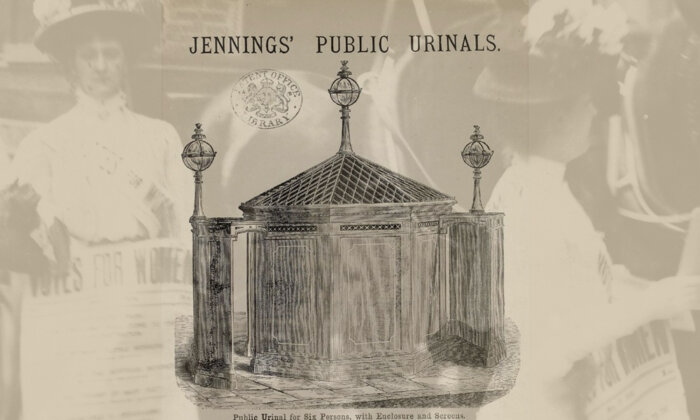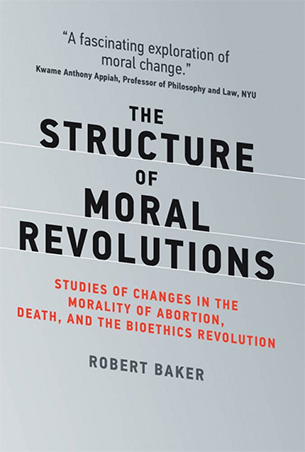Of Moral Reform and Equal Rights to Respectable Peeing

In the mid-19th century, ungenteel folks in the English-speaking cultural sphere urinated and defecated in the streets, in back alleys, or in the woods, whereas properly genteel people used chamber pots that their servants emptied into latrines: smelly places located as far from private or public dwellings as convenience and property lines permitted.

In 1851 the English sanitary engineer George Jennings (1810–1882) introduced a morally disruptive technology at London’s Great Exhibition. His innovation would bring the latrines, that is, outhouses, inside the house. To demonstrate the suitability of his new modern convenience, the flush toilet, Jennings exhibited the indoor outhouse not inside any old house but inside the magnificent cast-iron and plate glass structure housing the Great Exhibition, the Crystal Palace. People found Jennings’s invention — an outhouse fit to be placed inside a palace — so marvelous that 827,280 fairgoers purchased one-penny tickets (the 21st-century equivalent of about $10 per ticket) to see it and, should they wish, to actually use it. When ticket holders entered Jennings’s “lavatory” — Latin for “washroom,” a term that instantly became a standard euphemism (later joined by “water closet,” “WC,” and “restroom”) — they were ushered into a clean, well-lit room with gleaming white ceramic washbasins, towels, combs, and the central attraction, flush toilets in private stalls. To accommodate Victorian modesty, Jennings constructed two adjacent lavatories: one for men, the other for women.
Exactly 827,252 tickets were sold for the men’s lavatory, only 28 for the women’s lavatory. Prevailing standards of feminine modesty preempted curiosity and physiological necessity: Women feared to enter a public toilet lest they be seen as “vulgar.”
Prevailing standards of feminine modesty preempted curiosity and physiological necessity: Women feared to enter a public toilet lest they be seen as “vulgar.”
Women’s attitudes began to change with the opening of the London Underground Railway in 1863. The Underground created new employment opportunities for women who were willing to travel away from their homes. As women took advantage of this opportunity, access to respectable toilets during travel became a pressing issue. Since “any woman seen urinating in public degraded herself,” the absence of public toilets for respectable women meant that, as one historian put it, women either didn’t travel any distance from home, or if they did travel, they “didn’t go.” In 1878 the secretary of the Ladies Sanitary Association (LSA) of London (founded in 1857) sought to address the problem by urging every district board in London to become the first to offer pay WCs that accommodated respectable women. The LSA suggested:
A free W.C. should always exist at a paying station. … [and] supervision, &c., would be appreciated by many. The increasing number of women (working) of all classes who travel about London daily renders such provision of serious moment. … Whichever Vestry shall first give proof of humane consideration will have earned the gratitude of all women, and set an example that cannot fail to be beneficial to health and social morality.
To pause this narrative for a moment: Notice that technological changes, most notably the London Underground Railway, led to socioeconomic changes — “increasing number[s] of women (working)” outside the home — which, in turn, raised issues related to women’s “health and social morality,” which could be resolved if each district in London were to support a pay toilet for women with one free stall — and an attendant to ensure “social morality.” The all-male local councils of London were unresponsive to this request, but their debates over the proposed use of public funds brought the issue of women’s bodily needs out of the closet and into the pages of the Times.
Soon sanitary reformers found allies in the nascent women’s suffrage movement and its champions, like the Irish playwright George Bernard Shaw (1856–1950). In an essay, “The Unmentionable Case for Women’s Suffrage,” published in a new women’s suffrage magazine, the English Woman (1909–1921), Shaw points out that “in most places [in London] no sanitary accommodation was provided for [women] at all. … Even where accommodation was provided [it was] at a charge of one penny: an absolutely prohibitive charge for a poor woman and a very serious expense for [anyone with middle] income.” In 1901 a skilled telephone operator earned four pence an hour, and a typist three pence an hour. (To appreciate the working woman’s dilemma, had she been receiving $12 an hour, using a pay toilet would cost the equivalent of $4: a sum that many would find exorbitant, if not prohibitive.)
Shaw also reports that the debate over public toilets to accommodate women had morphed into “a grotesque struggle … [that] raged for years. … One councilor, … an enlightened man, of gentle manners and humane public spirit, passionately protested against ‘this abomination,’ as, in an excess of horror, he described the projected lavatory.” “Another,” he wrote, “urged that persons who so far ‘forgot their sex’ should not have anything provided for them at all.” On the other hand, as Shaw’s stand for women’s right to public toilets became known, he reported having received “piteous anonymous letters from women begging me to get the penny charge reduced to a halfpenny. These letters [also mentioned] all the little by-ways and nooks in the borough which afforded any sort of momentary privacy, [and thus] revealed a world of unmentionable suffering and subterfuge.”
“The climax was reached when, to test the excuse [that a proposed public] lavatory [open to both genders] would form a dangerous obstruction to traffic, a wooden obstruction of the exact dimensions of the proposed lavatory was placed on the site.” Now that women’s demand for equal access to public toilets was made manifest in a physical structure, London’s males felt free to give physical expression to their innermost feelings. As Shaw tells the tale:
In one day every bus on the … route, every tradesman’s cart … within a two mile radius, and most of the rest of the passing vehicles, including [many] driven to the spot on purpose, crashed into the [structure] with just violence enough to produce an accident without damage [to the vehicle]. The drivers who began the game were either tipped [i.e., paid] or under direct orders, but the joke soon caught on, and was kept up for fun. … In the end … the lavatory was not made.
After reviewing other cases of inequitable treatment of women, Shaw concludes by observing that he “hope[s] that I have said enough to show that the exclusion of women from public life is not only an injustice … but an abomination.”
From the perspective of hindsight, we might understand why an otherwise enlightened, humane, public-spirited man called a public toilet serving men and women an “abomination,” and why another said that women asking for public toilets “forgot their sex” and did not deserve a private place to pee, and why London men by the dozens jokingly destroyed a model of a lavatory that could accommodate women. Women were trespassing. Their place was not in the public sphere; it was in the domestic sphere, at home where they were to be cooking and cleaning, tending children, and attending church.
The public sphere was a man’s world, and it was improper, indecent, and an outright abomination for women to intrude and, worse yet, to intrude publicly in a manner that, to borrow Shaw’s metaphor, was less than angelic. They were violating a Victorian ideal of femininity as “angelic,” which meant that they, like angels, had to transcend their physiological needs, even if doing so meant enduring “unmentionable suffering.” The councilmen’s inchoate outrage, their condemnation of the planned lavatory as an “abomination,” and London males’ joking but proud physical assault on the mockup of a lavatory represented a defense of a man’s world against women who “forgot their sex” by demanding that men accommodate the all-too-physical side of their beings instead of assuming their properly “angelic” and domestic roles.
It may seem odd to focus on a dispute over access to toilets that erupted at the onset of the last century because, to us, the inequity of denying women equal access to toilets seems self-evident. Men today, however, have been educated by two waves of feminist revolutionaries. My purpose in resurrecting this long-forgotten dispute is to underscore my characterization of moral reformers as dissidents who aim at ameliorating the deleterious effects of an established morality, instead of trying to alter the moral paradigms that create these effects (in this case, Victorian conceptions of masculinity and femininity). Thus, as a sanitary and moral reform movement, the LSA sought to ameliorate the problem by providing separate but equal access to toilets. In doing so, the reformers invoked neither suffragette nor feminist ideals, only notions of sanitation and health. To this end, they secured testimonials from physicians attesting to the obvious fact that although “it is true that by the exercise of the will we can control for a time the muscular openings which serve as inlets and outlets to the body … such resistance … too frequently imposed upon women, if habitually practiced, is sure to be followed by injurious results.”
“The exclusion of women from public life is not only an injustice,” wrote George Bernard Shaw, “but an abomination.”
In contrast, Shaw, a Fabian socialist (i.e., a member of a socialist society founded in 1884), was a moral revolutionary who sought to change underlying moral paradigms, such as the “angelic” conception of femininity. The point that I am underscoring is that reformers accept existing paradigms and attempt to ameliorate their deleterious effects; revolutionaries seek to change paradigms underlying these effects.
This is not to claim that today we are enlightened enough to provide equal, nondiscriminatory access to toilets. Gender discrimination is palpably evident in the long lines of women waiting to use toilet facilities in the theaters and cinemas of my two favorite cities, New York and London — and, I would wager, in any English or American theater or cinema frequented by the reader. Why are there long lines outside women’s toilets and not outside men’s? Recall that mid-19th-century women believed it unladylike, immodest, and possibly indecent for women to use public toilets. Recognizing this sentiment, architects for public pay toilets put more urinals and toilets in the men’s sections than in the women’s. With a few notable exceptions, this asymmetry has been preserved in traditional lavatories designed and approved by (overwhelmingly male) architects, sanitary engineers, health inspectors ever since.
The egalitarian gesture of providing equal square footage for male and female lavatories merely perpetuates the inequity because (male) urinals take up less room than (male and female) toilet stalls, with the result that fewer stalls are available to women. The result is visible to any traveler or theatergoer: the “unmentionable suffering” of women described by Shaw more than a century ago is clear for every man to see and every philosopher to write about — and for every woman to cope with.
In the end, none of the all-male local governing bodies in London funded a public WC to accommodate women’s needs — although they did construct pay and free WCs for their fellow males. Capitalism came to the rescue. Wealthy women had always been able to travel to the heart of London to shop or attend the theater because they tucked chamber pots under the seats of their carriages or used respectable latrines behind the shops and cafés at which they made purchases, or the theaters they attended. Recognizing the potential new market of consumers that the Underground had created, in 1899 the Westminster Council funded London’s first public toilet facility accommodating both females and males, placing it beneath a major shopping district.
Readers might speculate about the council’s sociopsychological motives for burying London’s first public toilet for women beneath the ground; however, the council’s stated intentions were purely commercial. As the council reported in its annual report, the women’s section was equipped with “two mirrors, brushes, combs, &c., the idea being to provide all necessary accommodation for ladies shopping or doing business.” Fearful of losing their share of this emerging market, other London shopping areas also installed public pay toilets with opulent sections for respectable women, some even adopting an American innovation: a “restroom” for women to rest and refresh themselves. The outer London boroughs provided no public toilets for women, and the debate lingered on until it was resolved with Britain’s entry into World War I on August 4, 1914. As men departed for war, women were needed at the workplace, and necessity obsolesced traditional paradigms: Toilets accessible to women were swiftly built in public places and factories. By the 1920s, the issue had been resolved and forgotten.
Robert Baker is William D. Williams Professor of Philosophy at Union College in Schenectady, New York, and Professor of Bioethics and Founding Director (Emeritus) of the Bioethics Program at Clarkson University–Icahn School of Medicine at Mount Sinai in New York City. He is the author of “Before Bioethics: A History of American Medical Ethics” and “The Structure of Moral Revolutions,” from which this article is excerpted.




